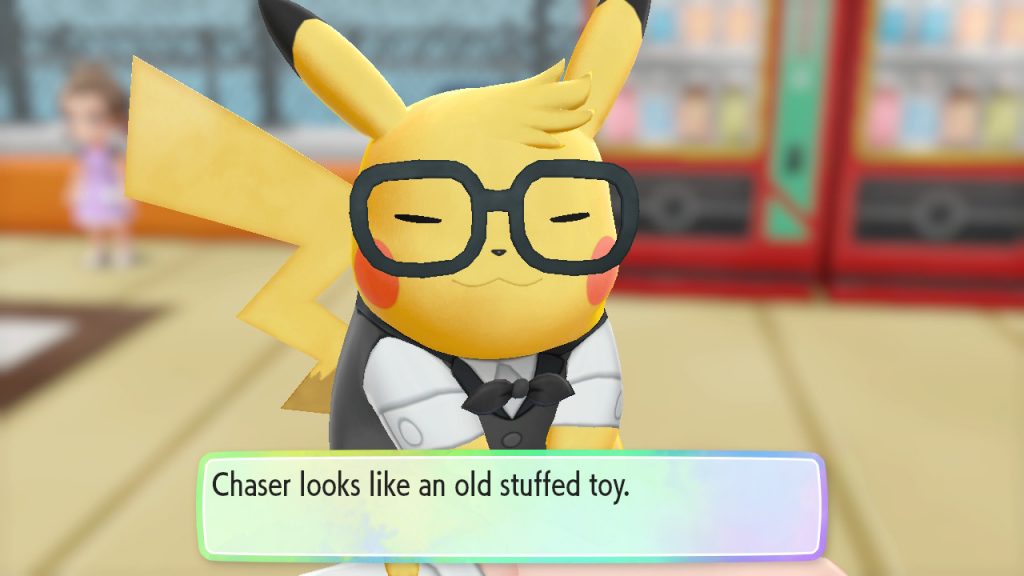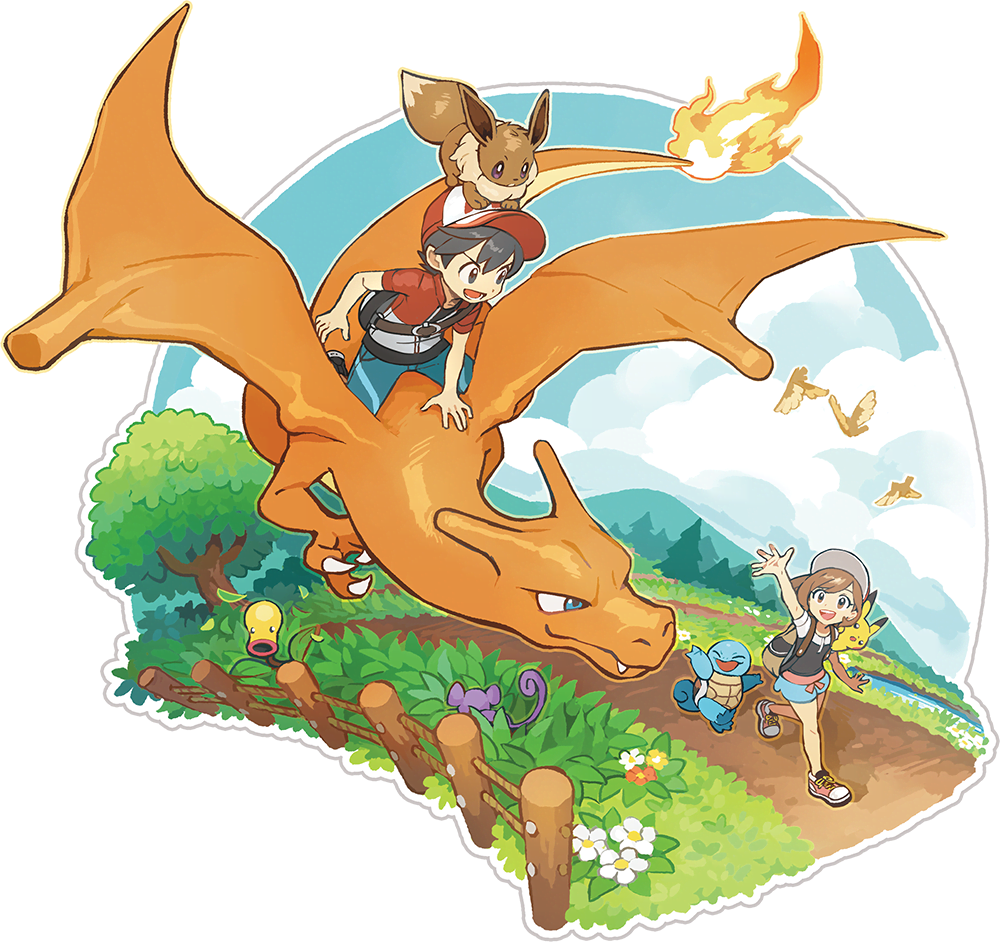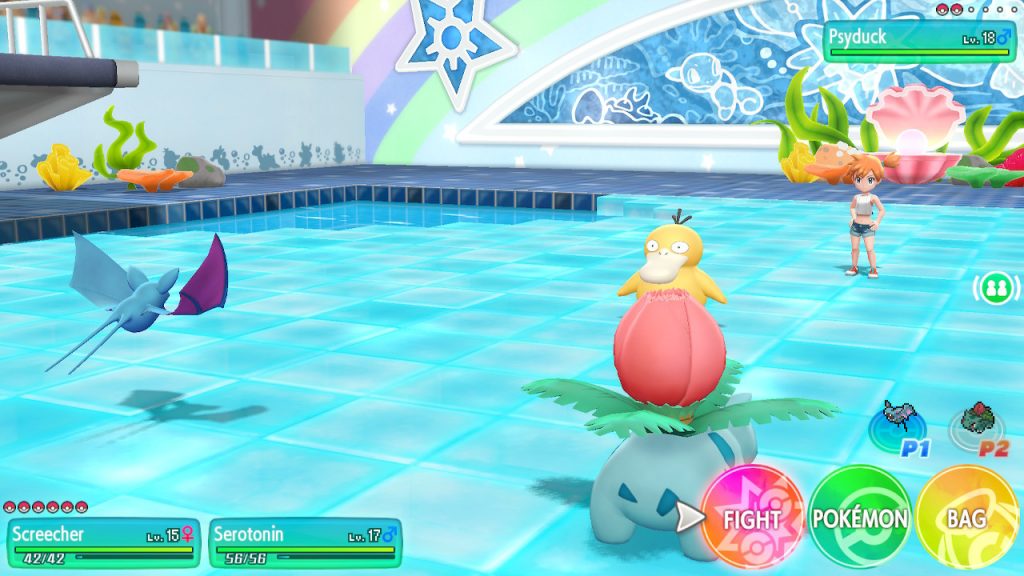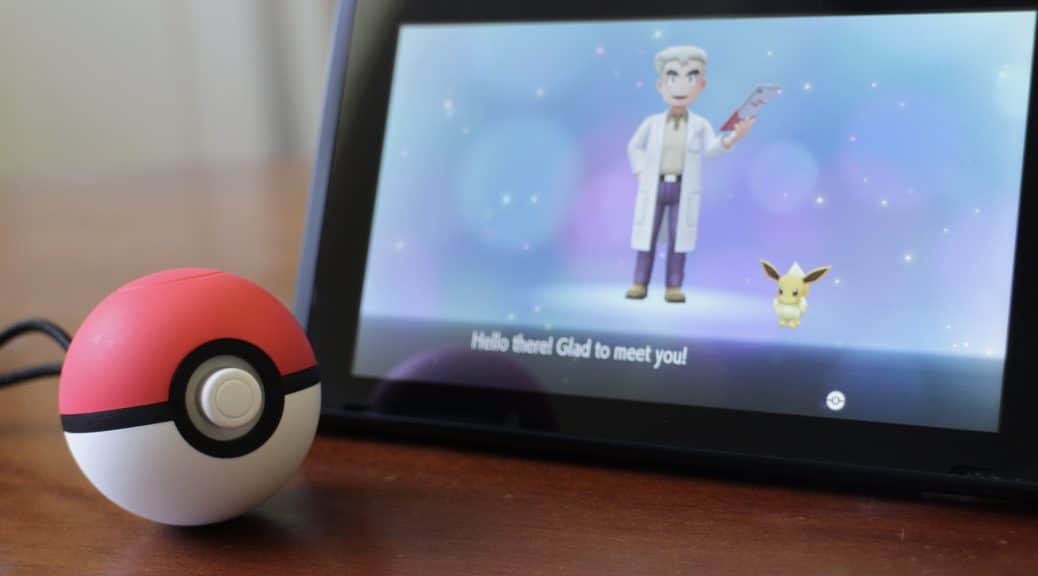Good, Fun Simplicity — Let’s Go Pikachu/Eevee and Poké Ball Plus Review
New Pokémon games are a great, yet different experience for all but the advanced battler. Both the games and the Poké Ball Plus are great complements to GO, too. Check out our extensive review on what’s different in Let’s Go, Pikachu! and Let’s Go, Eevee!
Grab Bag
Your Pikachu or Eevee brings the game to life

A headline feature in Pokémon: Let’s Go, Pikachu! and Pokémon: Let’s Go, Eevee! is your partner Pikachu or Eevee. Your partner is heavily involved in the story, given a load of cutscenes and acknowledgement from other characters. Set it as your first Pokémon, and your character even throws it into battle!
Fairly early in the game, a “Play with Pikachu” or “Play with Eevee” option becomes available in the start menu, and it works much like Pokémon-Amie from Pokémon X and Pokémon Y. Using either a motion-controlled cursor, or the Switch’s touch screen when undocked, you can pet your Pikachu or Eevee and feed it berries to raise its affection. It’s a really adorable mode and it’s well-animated, too — it’s really fun high-fiving your partner or poking its cheeks, or tickling it. Interactions can vary depending on the location or event — your partner may react in excitement after defeating a Gym Leader, with excitement when walking around, or with trepidation upon entering Pokémon Tower. It’s actually quite fun to check in on your partner from time-to-time to see what it may be up to.
Your partner Pokémon can also learn unique moves to help it tackle a wide range of types. Amongst Pikachu’s other Electric-type moves, it can learn Splishy Splash to help it deal with Rock types, Floaty Fall to help it with Flying-type Pokémon, and Zippy Zap for a fast Electric-type move. All three moves can also have secondary effects like striking first or inflicting Paralysis. Owing to its Normal typing, Eevee can learn a wider range of moves with a range of type coverage. Your partner Eevee’s unique moves are all damaging and, like Pikachu’s, also carry secondary effects. These moves are ridiculously powerful, with a power rating of 90.
Shaking a Joy-Con mid-battle when a special icon appears in the battle screen can also trigger a special move from your Pikachu or Eevee. If your partner is the one in battle, it triggers either the Electric-type Pika Papow for Pikachu, or Normal-type Veevee Volley for Eevee, both no-miss attacks that grow stronger the more affectionate your Pokémon is towards you. Type matchups still apply with these moves, so don’t waste Pika Papow on a Ground-type Pokémon! If you have another Pokémon in battle, shaking the Joy-Con allows your Pikachu or Eevee to support them by boosting all their stats by one stage in battle. Be aware that this will use up a turn, though. Keep in mind, too, that if the Switch is in Handheld mode and a separate Joy-Con is not connected, you will be unable to trigger these special moves.

At certain stages of the game, you’ll be given various outfits that both you and your partner Pikachu or Eevee can wear. It’s not as extensive as the customization seen since Pokémon X and Y, but it is the first time you’ll be able to fully customize the look of your partner Pokémon as they travel Kanto with you. Parts of each outfit can be mixed and matched for the combination you like. The game even encourages wearing matching outfits with your partner Pokémon. Cute! You’ll also be able to purchase accessories, like glasses or ribbons, from the Celadon Department Store — but only for your partner, sadly.
You can also use handheld mode and multiple fingers on the Switch touch screen to style your partner Pokémon’s hair via the “Play with Pikachu” or “Play with Eevee” screen. The requirements for attaining particular hairstyles, however, is not at all explained in-game. Even if you’ve found guides on the internet, the touch screen wouldn’t be receptive to giving your Pikachu or Eevee the hairstyle you want, particularly when trying to use eight fingers at once to convince the game to bestow a certain haircut to your partner Pokémon.
Once you’ve customized your partner Pokémon, your customized Pikachu or Eevee will show up with this appearance just about anywhere in-game — in battles, on the field, when playing with it, and even the game’s title screen! Extra cute!
Walking with your Pokémon is a thing again
 Pokémon Yellow introduced the concept of having a Pokémon follow you around the world, much like Ash Ketchum’s Pikachu follows him around in the TV series. This mechanic was re-introduced to players with Pokémon HeartGold and Pokémon SoulSilver, where the first Pokémon in your party would follow your character around the Pokémon world.
Pokémon Yellow introduced the concept of having a Pokémon follow you around the world, much like Ash Ketchum’s Pikachu follows him around in the TV series. This mechanic was re-introduced to players with Pokémon HeartGold and Pokémon SoulSilver, where the first Pokémon in your party would follow your character around the Pokémon world.
Despite the time and resources that would’ve had to be put in to make it happen in these games, this effort has not been implemented in games since then, although basic walking animations had been programmed into Pokémon Sun and Pokémon Moon.
Let’s Go, Pikachu! and Let’s Go, Eevee! bring this beloved feature back into the games. All 153 Pokémon in the game can follow you around almost everywhere. Most Pokémon have a unique way of following you around the world — we’ve already mentioned how Rattata scatters all over the place. Wild-caught Pikachu are more than happy to run ahead of you. Some Pokémon don’t even use their feet — they float. The Pokémon following you can once again be interacted with, yielding some cute interactions between you and your Pokémon. Some of these interactions can even vary depending on location and the specific Pokémon. They may also encounter items hidden within certain bushes in the game.
Like with HeartGold and SoulSilver, some Pokémon may be too large to enter some buildings, but for some of those Pokémon, you’ll probably notice that the game makes no attempt to scale them down to your size. Game Freak makes every attempt to capitalize on this, too — you’ll be able to ride on some of these large Pokémon. You’ll even be able to fly at ground level on some Pokémon (which, by the way, is probably why the Bicycle isn’t in these games). Upon finishing the story, those Pokémon will fly directly above most areas, encountering wild Pokémon in the sky.
The following mechanics in Let’s Go have a few issues. Pokémon may occasionally have issues following you and end up being stuck behind walls or fences. Once this happens and you get too far from them, they’ll abruptly transport back to you. They will also do this immediately after you jump down a ledge, suggesting there’s no animation for them to handle moving down a ledge. Larger Pokémon may also find themselves clipped by their surroundings, which doesn’t look right. Flying around in the sky with certain Pokémon sounds amazing, but it’s also hampered by invisible walls barring you from outright exiting the area. The invisible walls also stop you from going past areas separated by gates or caves, you’ll need to dismount the Pokémon to be able to continue. This normally wouldn’t be an issue if you could automatically dismount the Pokémon, but when you need to dismount them, you’ll have to go through the party screen to do so. When you’re doing this often, it can get really frustrating.
All in all, it’s a great mechanic to see again, and it’s nice to see it make the transition to a 3D Pokémon game. It has a few issues that leave it looking a little less perfect, and one particularly tedious one, but we can certainly be glad to see it here again. Let’s hope the feature finally becomes a permanent staple for future Pokémon games.
Co-op multiplayer can get pretty overpowered

The Let’s Go games are the first games in the Pokémon role-playing series to feature co-op multiplayer, and it’s available from the get-go. Simply connect another controller and shake it, and a player character of the other gender option will enter the field. The player can shake again to exit at any time. This makes for quick, casual exploration of the Pokémon world, but while walking around the world, the second player can’t do very much. It seems like a missed opportunity to be unable to trigger walk Pokémon encounters, pick up items, or interact with signs. The second player can also end up off-screen, and will either need to shake to exit and re-enter to be placed with the player again, or find their way back without being able to see themselves.
Where the co-op becomes useful is in wild encounters and Trainer battles. The second player can help catch wild Pokémon by throwing a Ball at it, while throwing it at the same time as the other player will play a special animation and yield a special catch bonus. In battles against other computer-controlled Trainers, a second player can send out one of your other Pokémon against the opponent. What’s more, they can hop into battle at any time by shaking the Joy-Con if they aren’t already connected.
The co-op is overpowered in battle, however, because it makes the game too easy. Pitting two Pokémon against one in what would normally play out as a single battle is simply unfair, and the computer player can’t send out a second Pokémon to combat yours. Because this power is available whenever you want, you may find yourself in a tight spot but trivialize it by calling a friend over to help you (or doing it yourself) to bring another Pokémon into battle and turn it into a curb-stomp.
Kanto’s 153 Pokémon
 You’ve no doubt heard that Pokémon: Let’s Go, Pikachu! and Pokémon: Let’s Go, Eevee! have scaled back from the 807 known Pokémon to the first 151 that started the series. With two bonus Pokémon, to boot, in the form of Meltan and Melmetal. It’s easy to see why Game Freak scaled back: they’re giving us all the Pokémon available in Pokémon GO’s initial release, who the bulk of new and returning players would have acquainted with. Given the timeframe between development for Pokémon Sun and Moon, Ultra Sun and Ultra Moon, and the upcoming eighth-generation games, it makes sense to work with the basics. Picking the first 151 both fit the setting and theme of Let’s Go and allows Game Freak to give every Pokémon featured in the game to come to life (even if just a little bit more than they already were).
You’ve no doubt heard that Pokémon: Let’s Go, Pikachu! and Pokémon: Let’s Go, Eevee! have scaled back from the 807 known Pokémon to the first 151 that started the series. With two bonus Pokémon, to boot, in the form of Meltan and Melmetal. It’s easy to see why Game Freak scaled back: they’re giving us all the Pokémon available in Pokémon GO’s initial release, who the bulk of new and returning players would have acquainted with. Given the timeframe between development for Pokémon Sun and Moon, Ultra Sun and Ultra Moon, and the upcoming eighth-generation games, it makes sense to work with the basics. Picking the first 151 both fit the setting and theme of Let’s Go and allows Game Freak to give every Pokémon featured in the game to come to life (even if just a little bit more than they already were).
The Alola Forms introduced in Pokémon Sun and Moon, plus Meltan and Melmetal, are the only recent Pokémon in these games. The inclusion of Alola Forms give the game some type balance, giving the Kanto region some well-needed Dark- and Ice-type Pokémon. Meltan is a brand-new Pokémon introduced in both the Let’s Go games and Pokémon GO. Meltan is unique — it’s a Mythical Pokémon with an evolutionary line in the form of Melmetal. Neither Meltan’s evolutionary line nor Alolan Pokémon can be obtained as wild Pokémon — they can be transferred from GO. Alola Forms may alternatively be obtained by trading the Kantonian variant to various non-player characters found throughout the region, and you can exchange more Kantonian species for Alolan variants at any time.
The decision to omit Pokémon past the first 151, with the complete exclusion of Pokémon evolutions past that number, is baffling, to say the least. The inclusion of Mega Evolutions allow certain Pokémon, a large number of Kanto Pokémon included, to become viable for battling, but the same can be said for evolutions of Pokémon such as Golbat, Rhydon and Chansey. Alola Forms may also be counted as new species that have little to do with Kanto, either, and yet these species, and not Pokémon such as Bellossom or Crobat, are included in the game. For anyone who’s been playing Pokémon GO since the start, who have also been able to evolve their Pokémon and inevitably find that they can’t transfer them to the Let’s Go games as a result, the exclusion of these new evolutions seems arbitrary. And when a lot of the fanbase, including GO players, would know about these evolutions at this point, it doesn’t sound like the best idea to leave them out.

The way to obtain Meltan is also particularly interesting, if somewhat drawn out. It can’t be captured directly in the Let’s Go games, requiring players who aren’t going to trade for one to use Pokémon GO to obtain one. While it (at the time of writing) can be obtained via a Special Research Quest in Pokémon GO, players of Let’s Go can easily obtain one once they reach the GO Park Complex — they unlock the ability to capture as many Meltan as you can find for a span of 30 minutes by using an item called the Mystery Box. The Mystery Box is first given to GO players once they’ve transferred at least one Pokémon from GO into the Let’s Go games. The ability to open the box can be triggered again one week after the last transfer.
Sounds like a slightly complex mechanic, right? If you’re aiming to get a Melmetal, this is where it gets lengthy. The lore states that Melmetal is formed by multiple Meltan merging together, referring to the idea of getting Candy from various Meltan in GO. To get a Melmetal, you will need 400 of them. This can be a tedious activity, as the most efficient way to get Candies — using Pinap Berries and catching multiple Meltan — is effectively restricted to 30 minutes each week. As a buddy Pokémon, you’ll need to walk 20 km to obtain Candy. As a result, even if you’re serious about catching ’em all, evolving just one Melmetal could take several weeks. Tedious as it is, though, the reward for your diligence is one of the strongest Mythical Pokémon around.
